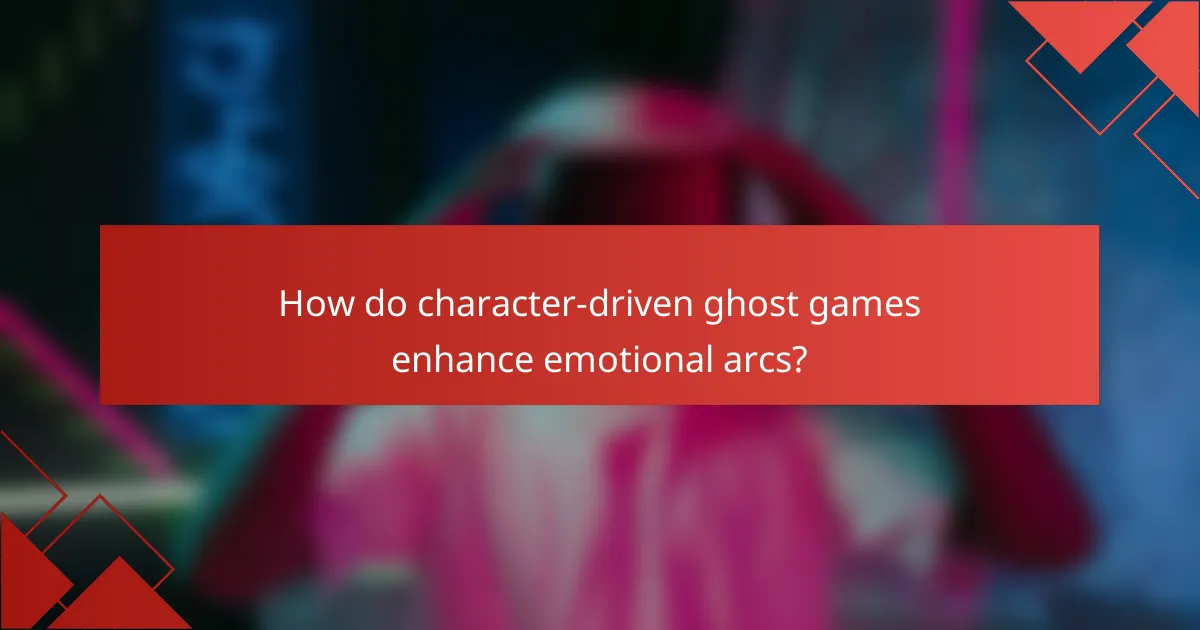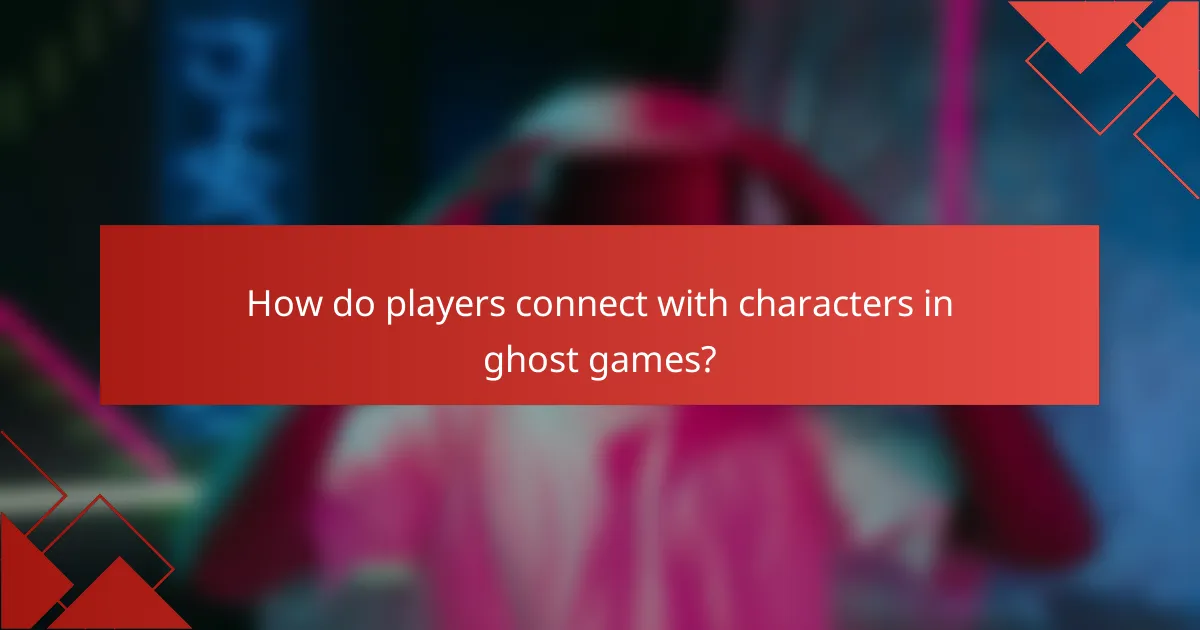Character-driven ghost games uniquely blend emotional storytelling with player experiences, allowing for profound connections to the characters and their journeys. By exploring themes of loss and relationships, these narratives engage players on a deeper level, fostering immersive experiences that resonate long after the game ends.

How do character-driven ghost games enhance emotional arcs?
Character-driven ghost games enhance emotional arcs by deeply intertwining player experiences with the narratives of the characters. This connection fosters a more immersive experience, allowing players to navigate complex emotions and relationships within the game world.
Deep character development
Deep character development is crucial in ghost games, as it allows players to form attachments to the characters’ stories. By providing rich backstories and emotional motivations, developers can create characters that resonate with players, making their journeys more impactful.
For example, a character who has lost a loved one may evoke feelings of empathy and reflection in players, encouraging them to explore their own emotions. Games that invest time in character arcs often see players more engaged and invested in the outcome of the story.
Player empathy and engagement
Player empathy is heightened in character-driven ghost games through relatable experiences and emotional storytelling. When players see their own struggles mirrored in a character’s journey, they are more likely to engage with the narrative on a personal level.
Engagement can be further enhanced by interactive elements that allow players to make choices affecting character outcomes. This sense of agency not only deepens emotional investment but also encourages players to reflect on their decisions and their impacts on the story.
Dynamic storytelling techniques
Dynamic storytelling techniques, such as non-linear narratives and multiple endings, can significantly enhance emotional arcs in ghost games. By allowing players to explore different paths and outcomes, developers create a sense of agency that can lead to varied emotional responses.
Implementing techniques like flashbacks or character-driven dialogue can also enrich the narrative, providing context and depth to the characters’ motivations. These methods keep players engaged and encourage them to explore the emotional layers of the story, leading to a more fulfilling gaming experience.

What are the key narrative focuses in ghost games?
Ghost games primarily focus on emotional storytelling that revolves around themes of loss, relationships, and deeper meanings. These narratives engage players by creating a strong connection to the characters and their journeys, enhancing the overall gaming experience.
Exploration of loss and grief
Loss and grief are central themes in ghost games, often depicted through characters dealing with the aftermath of a loved one’s death. Players may encounter situations that evoke feelings of sorrow and reflection, allowing them to empathize with the characters’ struggles.
For instance, a game might feature a protagonist who must confront memories of a deceased family member, leading to emotional revelations. This exploration can range from subtle hints to overt storytelling, creating a poignant atmosphere that resonates with players.
Interpersonal relationships
Interpersonal relationships in ghost games often serve as a vehicle for character development and emotional depth. These games typically showcase connections between the living and the deceased, emphasizing how these bonds affect the characters’ actions and motivations.
Players may navigate complex dynamics, such as unresolved conflicts or unfulfilled promises, which can lead to significant character growth. Engaging with these relationships can enhance player investment, making the narrative more impactful.
Symbolism and thematic depth
Symbolism plays a crucial role in ghost games, enriching the narrative with layers of meaning. Common symbols, such as ghosts representing unfinished business or memories, help convey deeper themes of regret and redemption.
Players may encounter various motifs, such as light and darkness, that reflect the characters’ emotional states. Understanding these symbols can enhance the gaming experience, prompting players to think critically about the story and its implications.

How do players connect with characters in ghost games?
Players connect with characters in ghost games through immersive storytelling, relatable experiences, and emotional engagement. These elements create a bond that enhances the overall gaming experience, making players feel invested in the characters’ journeys.
Relatable backstories
Relatable backstories are crucial for players to empathize with characters in ghost games. When characters have histories that mirror real-life struggles or emotions, players are more likely to connect with them. For example, a character dealing with loss or betrayal can resonate deeply with players who have faced similar situations.
Developing these backstories often involves incorporating universal themes such as love, grief, or redemption. This allows players to see parts of themselves in the characters, fostering a stronger emotional connection.
Player choice impact
Player choices significantly influence character development and narrative outcomes in ghost games. When players make decisions that affect a character’s fate, it enhances their investment in the story. For instance, choosing whether to help a character confront their fears can lead to different emotional arcs and endings.
Games that offer meaningful choices often encourage players to reflect on their decisions, creating a deeper connection with the characters. This interactivity can lead to varied experiences, making each playthrough unique and personal.
Emotional investment through gameplay
Emotional investment in ghost games is cultivated through gameplay mechanics that evoke feelings. Mechanics such as exploration of haunted environments, solving character-driven puzzles, or engaging in dialogue can draw players into the narrative. The more players engage with these elements, the more they care about the characters’ outcomes.
Additionally, incorporating moments of tension, surprise, or catharsis can heighten emotional responses. For example, a sudden revelation about a character’s past can shift the player’s perspective and deepen their connection, making the gameplay experience more impactful.

What are the best examples of character-driven ghost games?
Character-driven ghost games focus on emotional storytelling and player connection, often exploring themes of loss and remembrance. Notable examples include “What Remains of Edith Finch,” “Spiritfarer,” and “Oxenfree,” each offering unique narratives that engage players on a personal level.
What Remains of Edith Finch
“What Remains of Edith Finch” is a narrative-driven adventure that invites players to explore the Finch family home, uncovering the stories of its deceased members. Each story is presented in a distinct gameplay style, allowing players to experience the characters’ lives and deaths intimately.
The game’s strength lies in its emotional arcs, as players navigate themes of grief and memory. The varied storytelling techniques create a rich tapestry of experiences, making each character’s story impactful and memorable.
Spiritfarer
“Spiritfarer” combines management gameplay with a heartfelt narrative about guiding spirits to the afterlife. Players take on the role of Stella, a ferrymaster who builds relationships with the spirits she encounters, helping them resolve their unfinished business before they move on.
This game emphasizes emotional connection through its character interactions and the gradual development of friendships. The soothing art style and poignant storytelling encourage players to reflect on themes of loss, acceptance, and the importance of letting go.
Oxenfree
“Oxenfree” is a supernatural thriller that follows a group of friends who accidentally open a ghostly rift while on a trip to an abandoned island. The game features a unique dialogue system that allows players to shape the narrative and character relationships through their choices.
The focus on character-driven storytelling is evident as players navigate personal conflicts and supernatural elements. The blend of mystery and emotional depth creates a compelling experience, making players feel invested in the characters’ fates and the unfolding story.

What frameworks can enhance character-driven narratives?
Frameworks that enhance character-driven narratives focus on developing emotional arcs and fostering player connections. Techniques such as character arc mapping and player feedback integration are essential for creating immersive and engaging storytelling experiences.
Character arc mapping
Character arc mapping involves outlining the emotional and developmental journey of each character throughout the game. This process helps ensure that characters evolve in a way that resonates with players, making their experiences more impactful.
To effectively map character arcs, identify key moments that define the character’s growth, such as challenges faced or relationships formed. Use tools like flowcharts or spreadsheets to visualize these arcs, ensuring they align with the overall narrative structure.
A common pitfall is failing to connect character arcs with gameplay mechanics. Ensure that players’ choices influence character development, reinforcing the emotional stakes and enhancing engagement.
Player feedback integration
Integrating player feedback is crucial for refining character-driven narratives. By actively listening to players’ reactions and suggestions, developers can adjust story elements to better align with player expectations and emotional responses.
Consider using surveys, focus groups, or in-game analytics to gather insights on how players perceive characters and their arcs. This feedback can guide adjustments to dialogue, plot points, or character interactions, making the narrative more compelling.
Avoid making changes based solely on vocal minority opinions; instead, look for trends in feedback to ensure that adjustments resonate with a broader audience. Balancing player input with the original vision is key to maintaining narrative integrity while enhancing player connection.

What trends are emerging in character-driven ghost games?
Character-driven ghost games are increasingly focusing on emotional narratives and player connections, emphasizing mental health themes and personal growth. These trends enhance the immersive experience, allowing players to engage deeply with the characters and their struggles.
Increased focus on mental health themes
Many character-driven ghost games are now incorporating mental health themes as central elements of their narratives. This approach not only fosters empathy but also encourages players to reflect on their own emotional states and experiences. Games like “What Remains of Edith Finch” exemplify how storytelling can address complex issues such as grief and trauma.
When designing these narratives, developers often explore various mental health conditions, portraying them with sensitivity and depth. This can involve creating characters who deal with anxiety, depression, or loss, allowing players to connect with their journeys on a personal level. Such portrayals can help destigmatize mental health issues and promote awareness.
To effectively integrate mental health themes, developers should prioritize authentic storytelling and character development. Engaging players through relatable experiences can create a more impactful narrative, making the emotional arcs resonate deeply. Avoiding stereotypes and ensuring diverse representation are crucial for creating a respectful and meaningful dialogue around mental health.


